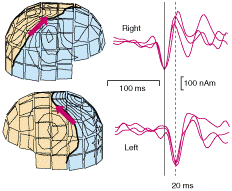SELECTED RESEARCH INTERESTS
Neuromagnetic studies of epilepsy
The new 122-channel neuromagnetometer has made measurements of spontaneous
brain activity feasible simultaneously over the whole head. This is a
significant improvement in the study of neurological patients. For example,
epileptic spikes are usually too individual to allow sequential measurements
covering only a small part of the brain at a time. Therefore, the magnetic
field during the spike must be mapped simultaneously over a large area to
allow determination of its generation site from a single positioning of the
instrument.
In about 20% of epileptic patients the results of medication are
unsatisfactory. Many such persons may benefit from removal of the tissue
producing the epileptic activity. In presurgical evaluation of patients with
intractable seizures originating in the cortex, MEG complements, and may even
replace invasive techniques such as depth or subdural electrode recordings,
which are used at present to locate the seizure-provoking area. These invasive
methods carry some risk, their use requires considerable expertise and, above
all, they cause discomfort and inconvenience to the patient. MEG could aid in
the selection of suitable candidates for intracranial implantation and in
focusing the surgical procedure to the right location. Furthermore,
simultaneous MEG measurements of epileptic activity and sensory evoked
responses may show an epileptic trigger in an essential brain area, thus
preventing surgery.
The advantages of MEG were well displayed in our study of a 36-year old woman
who had complex partial seizures of temporal lobe origin and up to 7 short
losses of consciousness per day for 23 years. Computed tomography showed a
large cyst in the right parietal region. In videotelemetric EEG, most
epileptic discharges were seen in the right temporal region but some peaked at
varying locations in the frontal midline. MEG showed frequent discharges with
maximum amplitudes over the right temporal area. The estimated sources had two
clearly different orientations but were restricted to a 2 × 2
cm2 zone in the right temporal lobe, 3 - 4 cm below the anatomical
abnormality and 4 cm posterior to the sources of evoked fields in the primary
auditory cortex. Currents with varying orientations at this location explained
the EEG spikes, whose maxima were several centimeters from their source.
Surgery was guided by the MEG localization, and an enlarged cortical gyrus was
found. In direct intracranial recordings, this area displayed maximal
epileptic activity and was resected. The patient has remained seizure-free
since then.

Fig 13. (Left) Magnetic field patterns during one epileptic
spike over the right (above) and left (below) hemispheres; the
isocontours are separated by 400 fT. Yellow indicates magnetic field out of
and blue into the head. (Right) Dipole strengths as a function of time.
Field patterns during three single spikes were analyzed and the results
superimposed. The acticity in the right hemisphere precedes that in the left
one by about 20 ms.
Until now, MEG studies have aimed at predicting the area involved in producing
the epileptic activity and in defining the regional extent of the abnormal
areas. However, the good spatial accuracy and the high temporal resolution of
whole-head MEG may also allow follow-up studies of the spread of epileptic
activity and elucidation of mechanisms producing epileptic foci. This was
demonstrated by our study of a 18-year old female epileptic patient whose
complex partial epilepsy, which had started at age 8, had initially been well
controlled by medication. During daytime seizures, she had tingling and
clumsiness in her left hand. In seizures during sleep, upper limbs were drawn
to extension and she had convulsions in them. Despite medication, her seizures
increased. MEG revealed epileptic activity in the right parietal region,
posterior to the source areas of the somatosensory evoked fields.
Corresponding spikes were seen 20 ms later in the homologous cortical area of
the opposite hemisphere. This "mirror focus" had probably developed during the
disease.






